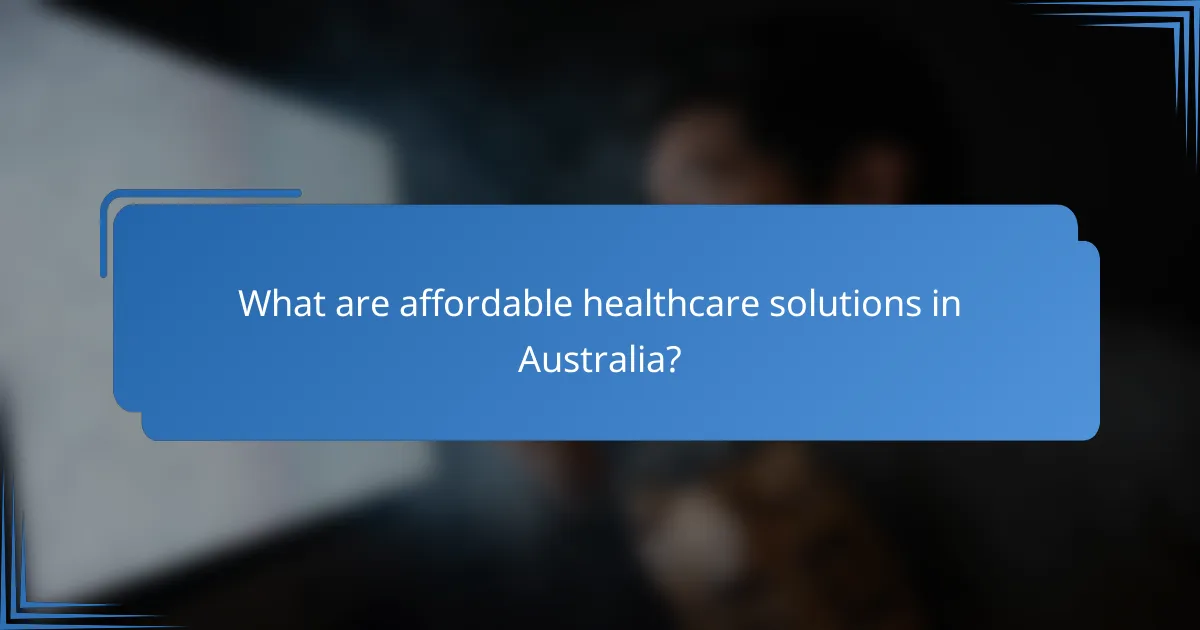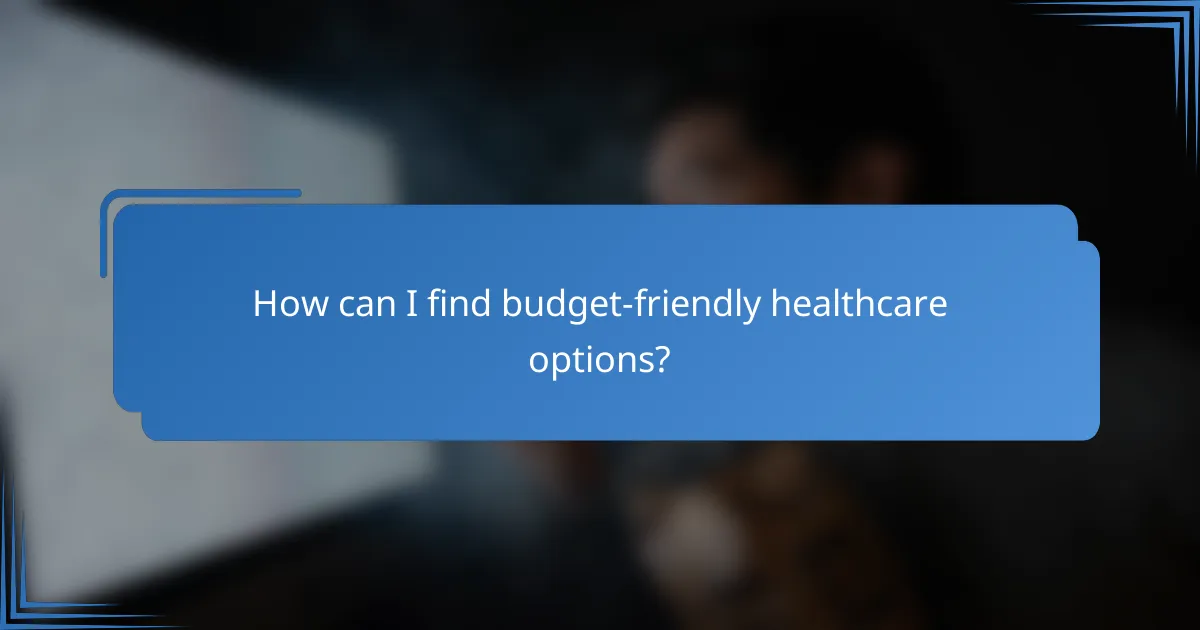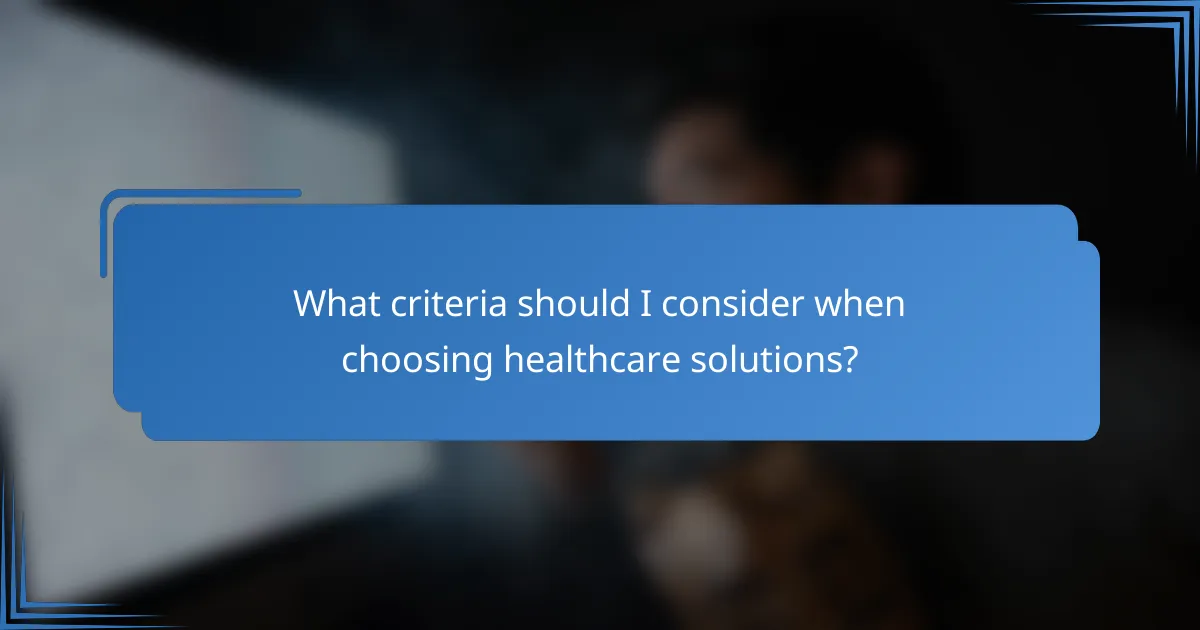Affordable healthcare solutions offer a range of cost-effective options aimed at ensuring accessible medical care without overwhelming personal budgets. From telehealth services to community health programs and bulk-billing clinics, these alternatives are designed to deliver high returns on investment while improving overall health outcomes.

What are affordable healthcare solutions in Australia?
Affordable healthcare solutions in Australia encompass various cost-effective options designed to provide accessible medical care without straining personal finances. These solutions include services like telehealth, community health programs, bulk-billing clinics, and alternative health insurance plans that offer high returns on investment.
Telehealth services
Telehealth services allow patients to consult healthcare professionals remotely, often at a lower cost than traditional in-person visits. This option is particularly beneficial for those in rural areas or individuals with mobility challenges, as it reduces travel expenses and time.
Many telehealth platforms in Australia are covered by Medicare, meaning that eligible patients can access these services at no out-of-pocket cost. Always check if your provider offers bulk-billed telehealth consultations to maximize savings.
Community health programs
Community health programs provide essential services at little to no cost, focusing on preventive care and health education. These programs often target specific populations, such as low-income families or Indigenous communities, ensuring that healthcare is accessible to those who need it most.
Examples include free immunization clinics, health screenings, and wellness workshops. Engaging with local community health services can significantly reduce personal healthcare expenses while promoting overall well-being.
Bulk-billing clinics
Bulk-billing clinics offer medical services where the provider bills Medicare directly, allowing patients to receive treatment without any out-of-pocket expenses. This system is particularly advantageous for those with limited financial resources, as it eliminates the need for upfront payments.
When seeking a bulk-billing clinic, look for those that advertise this service prominently. Many general practitioners and specialists participate in bulk-billing, making it easier to find affordable care.
Health insurance alternatives
Health insurance alternatives, such as health savings accounts or low-cost health plans, can provide budget-friendly options for managing healthcare costs. These alternatives often come with lower premiums and can be tailored to meet individual health needs.
Consider comparing different plans to find one that balances coverage with affordability. Additionally, some providers offer discounts for preventive care services, which can further enhance the value of these alternatives.

How can I find budget-friendly healthcare options?
To find budget-friendly healthcare options, start by researching various resources that provide cost-effective solutions tailored to your needs. Consider using online tools, government initiatives, and local directories to compare services and prices effectively.
Online comparison tools
Online comparison tools allow you to evaluate healthcare plans and services side by side, helping you identify the most affordable options. Websites like HealthCare.gov or private insurance comparison sites can provide insights into premiums, deductibles, and coverage levels.
When using these tools, input your specific healthcare needs and budget to receive tailored results. Look for features such as customer reviews and ratings to gauge the quality of care associated with each option.
Government health initiatives
Many governments offer health initiatives aimed at making healthcare more affordable. In the U.S., programs like Medicaid and the Children’s Health Insurance Program (CHIP) provide low-cost or free healthcare for eligible individuals and families.
Check your local government’s health department website for information on available programs, eligibility criteria, and application processes. These initiatives can significantly reduce out-of-pocket expenses for essential medical services.
Local health service directories
Local health service directories can help you find budget-friendly healthcare providers in your area. These directories often list clinics, hospitals, and specialists along with their pricing structures and services offered.
Utilize resources like the National Association of Free and Charitable Clinics or local health department listings to discover low-cost options. Be sure to verify the quality of care by checking reviews or asking for recommendations from community members.

What are the benefits of high ROI healthcare solutions?
High ROI healthcare solutions provide significant advantages, including cost savings, improved health outcomes, and increased access to essential services. These benefits not only enhance patient care but also contribute to the sustainability of healthcare systems.
Cost savings over time
Implementing high ROI healthcare solutions can lead to substantial cost savings in the long run. By focusing on preventive care and efficient resource allocation, healthcare providers can reduce expenses associated with chronic disease management and emergency interventions.
For example, investing in telemedicine can lower overhead costs while providing patients with timely access to care. This approach can save healthcare systems tens of thousands of dollars annually by minimizing hospital admissions and unnecessary treatments.
Improved health outcomes
High ROI healthcare solutions often lead to better health outcomes for patients. By emphasizing preventive measures and early interventions, these solutions can significantly reduce the incidence of severe health issues.
Programs that promote regular screenings and vaccinations, for instance, can decrease the prevalence of diseases, resulting in healthier populations and lower healthcare costs. This proactive approach can improve life expectancy and quality of life for many individuals.
Increased access to services
High ROI healthcare solutions enhance access to medical services, particularly in underserved areas. By utilizing technology, such as mobile health applications and telehealth platforms, patients can receive care without the barriers of distance or transportation.
These solutions can bridge gaps in healthcare access, ensuring that more individuals receive timely and appropriate care. For example, rural communities can benefit from virtual consultations, making it easier for residents to connect with specialists without traveling long distances.

What criteria should I consider when choosing healthcare solutions?
When selecting healthcare solutions, consider factors such as cost, coverage, provider reputation, and service availability. These criteria will help you identify options that are both budget-friendly and effective in meeting your healthcare needs.
Cost vs. coverage analysis
Begin by evaluating the balance between cost and coverage. Affordable healthcare solutions should provide adequate coverage without overwhelming your budget. Look for plans that offer essential services at a reasonable price, typically ranging from a few hundred to a couple of thousand dollars annually.
Compare deductibles, copayments, and out-of-pocket maximums across different plans. A lower premium may come with higher out-of-pocket costs, so ensure you understand the total financial commitment involved.
Provider reputation
Research the reputation of healthcare providers to ensure quality service. Look for reviews, ratings, and testimonials from other patients. A provider with a strong reputation often indicates better care and patient satisfaction.
Check if the provider is accredited by recognized organizations, as this can be a sign of adherence to industry standards. Additionally, consider how long the provider has been in business and their track record in your specific area of concern.
Service availability
Assess the availability of services offered by the healthcare solution. Ensure that the services you need are accessible within your locality and that the provider has a network of specialists if required. This is particularly crucial for ongoing treatments or specialized care.
Look for options that offer telehealth services, which can enhance accessibility and convenience. Confirm that the provider has adequate facilities and staff to handle your healthcare needs efficiently, especially during peak times or emergencies.

What are the emerging trends in affordable healthcare?
Emerging trends in affordable healthcare focus on innovative solutions that reduce costs while maintaining quality. These trends include the integration of technology, preventive care strategies, and community-based health initiatives.
Digital health innovations
Digital health innovations are transforming the landscape of affordable healthcare by leveraging technology to enhance access and efficiency. Telemedicine, mobile health apps, and wearable devices are key components that allow patients to receive care remotely, reducing the need for in-person visits and associated costs.
For instance, telehealth platforms can connect patients with healthcare providers at a fraction of the cost of traditional consultations, often charging lower fees or even offering services covered by insurance. Additionally, mobile health applications can help individuals manage chronic conditions, track health metrics, and receive reminders for medication, which can lead to better health outcomes and lower overall healthcare expenses.
When considering digital health solutions, it’s essential to evaluate the technology’s usability, security, and integration with existing healthcare systems. Patients should also be aware of potential limitations, such as the need for reliable internet access and the possibility of reduced personal interaction with healthcare providers.
